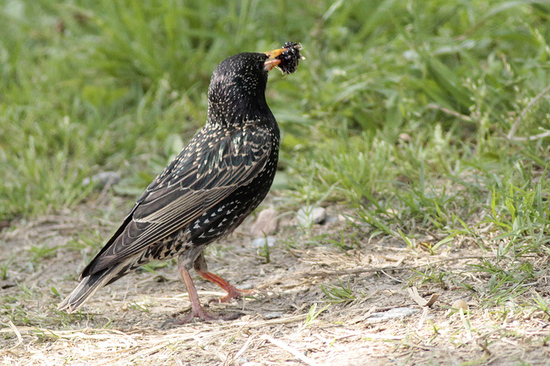Two exotics: European starling and mulberry
Man has always moved with his culture on his back throughout history. For whatever reason: cultural nostalgia, economic reasons, deliberately or accidentally the introduction of plants and animals has caused in the receiving environment an unequal struggle. The exotics have not their natural predators which control the spread of the population to such an extent that they grow out of control and become pests. This caused the regression of the autoctonous flora and fauna and became a call of attention, which has lead the Government to legislate on the protection and conservation of native flora and fauna. Nevertheless, fulfilment of the law is still not a priority.
.
.
In this photo two introduced species: the European Starling Sturnus vulgaris with a fruit of the Mulberry Tree Morus nigra in its bill. This tree is native to Eurasia. Its fruit is fleshy and purple and is highly appreciated by birds which disseminate the seeds. In the reserve this tree has easily spread.
The first records of the European Starling in Buenos Aires date back to the late ’80. According to investigations it has expanded along the coast of the Province of Buenos Aires till Mar del Tuyú. At Costanera this is a resident bird and its presence was first recorded in 1997 as Germán Pugnali points out. It is very aggressive: it pushes native birds or migratory birds in their competence for food and nests. It is opportunistic: it makes do with anything it can get. It has a high rate of reproduction: according to studies it would almost double their population yearly.
The negative impact this bird caused at an economic an ecological level in other countries where it was also introduced has been broadly investigated. We must learn from this experience to avoid this situation. Population growth is so fast that it becomes imperative to take measures to erradicate this species before it is too late.
The first records of the European Starling in Buenos Aires date back to the late ’80. According to investigations it has expanded along the coast of the Province of Buenos Aires till Mar del Tuyú. At Costanera this is a resident bird and its presence was first recorded in 1997 as Germán Pugnali points out. It is very aggressive: it pushes native birds or migratory birds in their competence for food and nests. It is opportunistic: it makes do with anything it can get. It has a high rate of reproduction: according to studies it would almost double their population yearly.
The negative impact this bird caused at an economic an ecological level in other countries where it was also introduced has been broadly investigated. We must learn from this experience to avoid this situation. Population growth is so fast that it becomes imperative to take measures to erradicate this species before it is too late.


